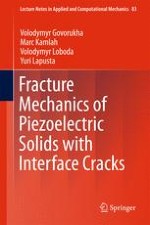This book provides a comprehensive study of cracks situated at the interface of two piezoelectric materials. It discusses different electric boundary conditions along the crack faces, in particular the cases of electrically permeable, impermeable, partially permeable, and conducting cracks. The book also elaborates on a new technique for the determination of electromechanical fields at the tips of interface cracks in finite sized piezoceramic bodies of arbitrary shape under different load types. It solves scientific problems of solid mechanics in connection with the investigation of electromechanical fields in piezoceramic bodies with interface cracks, and develops calculation models and solution methods for plane fracture mechanical problems for piecewise homogeneous piezoceramic bodies with cracks at the interfaces. It discusses the “open” crack model, which leads to a physically unrealistic oscillating singularity at the crack tips, and the contact zone model for in-plane straight interface cracks between two dissimilar piezoelectric materials. It also investigates the model of a crack with electro-mechanical pre-fracture zones. The formulated problems are reduced to problems of linear relationship, which correspond to different crack models, and their exact analytical solutions are found. The book presents in detail the expressions for stress and electric displacement intensity factors, as well as for the energy release rate. The influence of the electric permittivity of the crack, the mechanical load and the electric field upon the electro-elastic state, as well as the main fracture mechanical parameters, are analyzed and clearly illustrated.
This book addresses postgraduate students, university teachers and researchers dealing with the problems of fracture mechanics of piezoelectric materials, as well as engineers who are active in the analysis of strength and durability of piezoelectric constructions.
